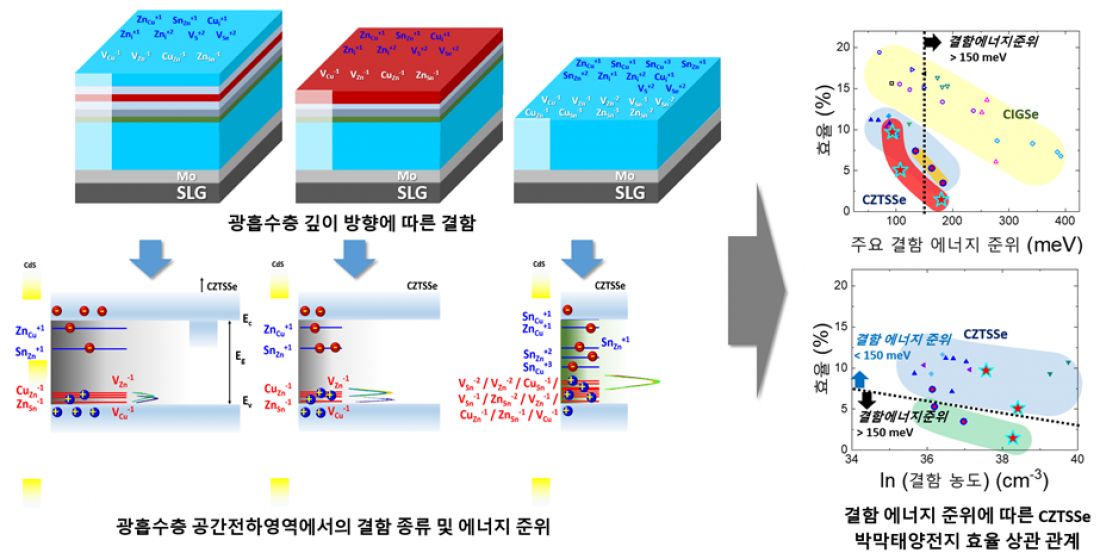A research team led by Yang Kee-Jeong and Kim Dae-Hwan at the Division of Energy Technology, Daegu Gyeongbuk Institute of Science & Technology (DGIST; President Kuk Yang) and Kang Jin-Gyu at the Research Center for Thin Film Solar Cells, DGIST announced on April 4th that they proposed, based on the admittance spectroscopy of kesterite thin-film solar cells, a defect energy level in the absorption layer that deteriorated thin-film solar cell properties; they identified the specific types of defects in a joint study with Professor Kim Jun-Ho at the Department of Physics, Incheon National University (President Park Jong-Tae).
Solar cells, which convert the sun's light energy into electrical energy to generate electricity, are one of the sustainable renewable energy sources which can be easily found in real life. In particular, kesterite thin-film solar cells consist of earth-abundant elements, including copper, zinc, tin, sulfur, and selenium, and have the advantage of resolving concentrated resources or instability in supply and demand. However, the low efficiency of kesterite thin-film solar cells is a disadvantage that must be overcome to build an industrial ecosystem and expand the market for these cells. To overcome low efficiency, it is crucial to understand defect properties in the kesterite light-absorbing layer.
Defects in the light-absorbing layer of a solar cell may cause a loss of recombination in carriers (electrons and holes), and a defect cluster can change a band gap (energy absorption band) in the light-absorbing layer; this shortens the diffusion length and carrier lifetime. Therefore, identifying the defect or defect cluster that affects these properties is critical.
This study observed the properties of defects and defect clusters in a kesterite polished-surface light depth-dependent absorption layer based on admittance spectroscopy (AS). The research team found defects and defect clusters were more easily formed in the area with a large elemental variation in the light absorption layer. A defect with a deep energy level of more than 150 meV drastically deteriorated the properties of kesterite thin-film solar cells.
□ Due to a low level of mobility of carriers in kesterite thin-film solar cells, the researchers found that carrier diffusion length further decreased as the defect energy level deepened on the surface of the light-absorbing layer, leading to decreased electric current properties. Consequently, they suggested the main reason for the deteriorated properties was the large amplitude of the band gap fluctuation arising from the defect that caused greater carrier recombination and a shorter carrier lifetime, reducing voltage and electric current properties.
□ This study holds great significance as it suggested that it is crucial to prevent the formation of defects with deep energy levels at the interface of the light absorber layer to improve the efficiency of kesterite thin-film solar cells; it proposed the range of deep main defect energy levels of over 150 meV from experiment results, and identified the specific types of defects.
□ Senior Researcher Yang Kee-Jeong at the Division of Energy Technology, DGIST said, "This study’s method is expected to provide directions in research for understanding defect properties and improving efficiency not only for kesterite thin-film solar cells but also other types of solar cells."
□ Meanwhile, this study was conducted as part of the Ministry of Science and ICT’s Original Technology Development Project (Step-by-Step Carbon Neutral Technology Development) and Future Leading Characterization Research Project (Grand Challenge Research and Innovation Project (P-CoE)). It was published online on March 10th in Carbon Energy (IF=21.556), one of the most important international journals in the Energy field.
Correspondence Author Email Address : [email protected]



